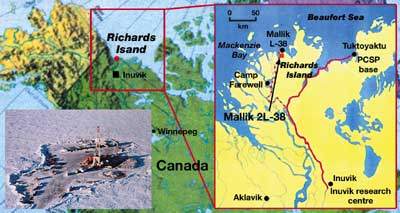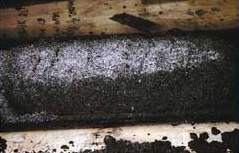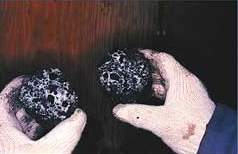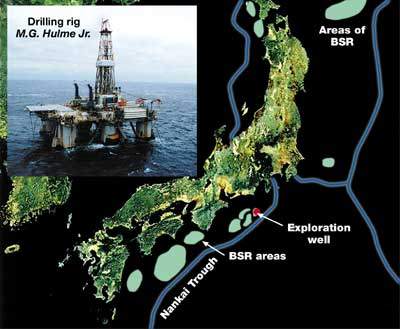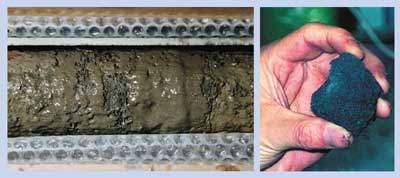Gas hydrate research continues to increase
Gas hydrates research continues to increaseGas hydrates research is almost a growth industry. Exploration drilling has been successful, but the world still awaits proof that it is a bona fide resourcePerry A. Fischer, Engineering Editor
Interest persists because if only 1% to 2% of estimated in situ hydrates could be economically recovered, it would become an enormous, world energy resource. This article reviews current gas hydrate research efforts, including the drilling of two exploration research wells. Introduction The distribution of worldwide hydrocarbon resources has caused many hydrocarbon-poor nations to seek ways to lessen their ever-increasing hydrocarbon imports. Japan, for instance, has very limited hydrocarbon resources. Domestic oil and gas production is only 0.25% and 3.0%, respectively, of annual consumption, which is currently 5.55 million bopd and 6.57 Bcfgd. Gas hydrates carry high hopes as an unconventional natural gas resource because of their potential to contribute to the future energy supplies of hydrocarbon-poor countries. What they are. Hydrates are ice lattices, or clathrates, with gases trapped within them. This trapping compresses the gas at roughly a 160:1 ratio relative to surface conditions. Hydrates have, so far, been discovered in three forms: Structures I, II and H. Structure I is the most common and is often composed of biogenic methane. Structures II and H can contain larger hydrocarbon molecules that derive from thermogenic gas.2 Where they are. Hydrates are believed to occur in deepwater continental margins throughout the world. They would most likely be found in water depths greater than 1,100 ft in sediments as deep as 3,000 ft, but favor shallower sediments, and are sometimes seen as outcrops on the seafloor. However, small changes in thermal gradient, seafloor temperatures, and water and gas chemistry can shift the zone of hydrate stability. A minor, but important, percentage occurs in permafrost regions at depths below about 600 ft. Research Overview Five areas of current research involve gas hydrates. Production impediment. Research continues for discovering the most cost-effective methods to eliminate hydrate formation in trees, flowlines and pipelines. Project DeepStar’s 4.5-mi Hydrate Research Flow Loop in Wyoming is a good example. Gas transport. Norway has been studying the feasibility of transporting otherwise-stranded gas by converting the gas into hydrates. Results of this research indicate that gas transport can be economically achieved, especially when Structure H hydrates are employed.3 Climate modeling. Atmospheric concentration of methane with respect to ocean-atmosphere or ocean-sediment exchange is not understood. If hydrates do play a role, they are a secondary climate effect. Formation / disassociation of hydrates would occur as a response to changes in temperature and sea levels. Increasing ocean depths would tend to expand the zone of hydrate stability, whereas warmer seafloor temperatures would tend to decrease it. Drilling hazard. For countries with ample offshore gas reserves, this topic is receiving considerable attention. Hydrates are suspected of playing a role in shallow water flows and shallow gas blowouts, as well as slope instability. A panel of experts at a deepwater workshop, organized by the Society of Exploration Geophysicists, unanimously felt that shallow water flows presented the greatest obstacle to deepwater drilling worldwide. Energy resource. This is the focus for hydrocarbon-poor countries. It offers their best hope for finding domestic gas supplies. Interest continues to accelerate, with many governments – such as the U.S., Japan, Korea, Canada, Norway and India – actively funding research programs. In May 2000, the U.S. Methane Hydrate Research and Development Act became law; it provides $47.5 million for hydrates R&D over the next five years. However, Japan has been the most active in trying to develop hydrates as a resource and plans commercial production within a decade. E&P Considerations Exploration methods. The primary exploration method is to look within the hydrate stability zone for a bottom-simulating reflector (BSR). BSRs are strong reflectors that result from impedance contrasts that are thought to be caused by free gas trapped beneath hydrates. Because hydrate formation is a function of pressure, temperature, and water and gas composition, BSRs do not always perfectly follow the seafloor contour and may cut across lithology. However, like all direct hydrocarbon indicators, BSRs are not reliable. Hydrates have been recovered where there is no BSR, and BSRs exist where there are no hydrates. Analysis of gas hydrate cores show that acoustic velocity is relatively high in hydrates, and this helps in identifying them. Another method is similar to conventional gas identification on seismic images: Look for blurred "wipeout" zones where hydrates form plugs and chimney-like structures. This is particularly true in the Gulf of Mexico, where BSRs are mostly absent. The GOM may be too geologically active to allow BSR formation. Hydrocarbon areas that have abundant seeps, such as the GOM and offshore West Africa, offer the best chance for hydrate production, because hydrates there are more likely to be thick and contain richer (energy), thermogenic gas.4 Exploratory drilling. The Ocean Drilling Program (ODP) continues its worldwide drilling / coring program with the drillship JOIDES Resolution. The drillship is riserless and does not attempt to produce gas from hydrates. However, Japan has now committed to building a riser-equipped drillship. In August 2001, Leg 204 of the ODP will drill three holes on Hydrate Ridge offshore Oregon – each 1,300 to 2,300 ft deep. Japan has drilled two major hydrate-exploration research wells: Mallik 2L-38 and Nankai Trough. Mallik 2L-38. In 1998, a gas hydrate research well was drilled to 3,773-ft TD in the Mackenzie Delta, Canada, under collaboration with the Geological Survey of Canada, Fig. 1. Collaboration between Technology Research Center / Japan National Oil Co. (JNOC) and private companies enabled development / testing of technologies related to the drilling operation: a mud system specifically designed for gas hydrate, including a mud-cooling system; a Pressure Temperature Coring System (PTCS); logging methods; resource assessment; and basic gas hydrate properties. Mallik was a test bed for the Nankai Trough well.
Hydrates were recovered in cores taken between 2,907 and 3,125 ft. They comprised a sand matrix with 20% to 40% porosity – mostly hydrate filled – with peak hydrate saturation exceeding 90%, Fig. 2. These were the first gas hydrate cores recovered from a permafrost well.
MITI / Nankai Trough. In 1996, a seismic survey targeting gas hydrates was conducted in the Nankai Trough area offshore Japan. Based on BSRs seen on this survey, a stratigraphic exploratory well was sited in 3,100-ft waters off Omaezaki Cape and, in November 1999, drilled to 10,827-ft TD, Fig. 3. The drilling of the MITI / Nankai Trough well culminated the Phase I part of a gas hydrate research program launched in 1995.
The Japanese Ministry of International Trade and Industry (MITI) financed the initiative, while JNOC coordinated between the government and 10 private companies. Japex subcontracted the semisub rig M.G. Hulme Jr. and several service companies for the drilling. There were two objectives for the Nankai Trough site: a relatively shallow, gas hydrate layer and a deeper, conventional-hydrocarbon wildcat. The conventional target came up dry, but methane hydrates were confirmed in sandstone layers located between 656 ft and 886 ft below the seabed, with some horizontally continuous extent and with a hydrate saturation as high as 60% to 80% of available porosity, Fig. 4. Cores of methane hydrates in sandstone are the first such offshore discovery in the world, according to Japex officials. A full suite of well logs was also run.
Production. Production from gas hydrates may have occurred in the Messoyakha gas field in West Siberia. The topic was recently revisited in a paper presented at the 2000 Western Pacific Geophysics Meeting.5 The authors concluded that it was likely that some hydrates might be present (or were present before production) in marginal areas of the field, and that production activity may have caused subsequent hydrate formation. Mostly, however, the evidence was again inconclusive. Three strategies have been suggested for gas hydrate production: 1) heating the formation, 2) depressurization, and 3) chemical injection. Thus far, only one attempt has been made to produce hydrates intentionally. Production via depressurization of a hydrate-bearing formation occurred in 1972 in the Northwest Eileen State 2 well in Prudhoe Bay field. The well tested at 3.9 Mcfgd.6 A new well, whose focus would be on production testing, has been proposed at the Mallik wellsite for early 2002. Summary Research into every aspect of gas hydrates continues to accelerate. Governments, universities and private operators have shared resources to study aspects of gas hydrates, such as their role as a drilling hazard, a production impediment or a production transportation method. As a resource, it remains unproven. Exploration results to date are
encouraging, but they also indicate high variability in gas hydrate deposits. Thus, it is likely that a
similar variability will extend into E&P economics. Hydrocarbon-importing nations are making significant
investments in research to assess hydrate as a resource. So far, much of the work is taking place in labs, but
only the drillbit and production testing can prove the resource. Acknowledgment The author thanks Dr. Akio Sakai, senior researcher, Exploration Technology, Exploration Division, Japex; Dr. Nobuyoshi Baba, director, JGI, Inc.; and Hironori Wasada, Technical Department director, JNOC for their assistance in providing information and figures for this article. Literature Cited
|

